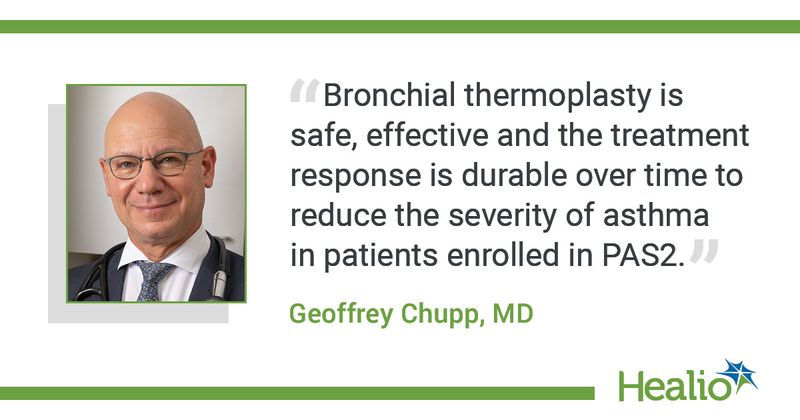Bronchial thermoplasty for severe asthma safe, effective, durable at 5 years
Patients with severe asthma experienced decreased exacerbations, hospitalizations, ED visits and corticosteroid exposure 5 years after treatment with bronchial thermoplasty, researchers reported.
Five-year safety and efficacy data from the Post-FDA Approval Clinical Trial Evaluating Bronchial Thermoplasty in Severe Persistent Asthma Study (PAS2) were published in Chest.

“With approval of bronchial thermoplasty, and any therapy, there are always questions about long-term efficacy and safety — this prompted the PAS2 trial,” Geoffrey Chupp, MD, professor of pulmonary medicine and director of the Yale Center for Asthma and Airways Disease and Pulmonary, Critical Care and Sleep Medicine and director of the Pulmonary Function Laboratory at Yale-New Haven Hospital, Yale University, told Healio.
PAS2 was a prospective, open-label, observational study of 279 patients with severe asthma (mean age, 45.7 years; 64.5% women) from 27 centers in the U.S. and Canada. All patients were on inhaled corticosteroids ( 1,000 µg per day) and long-acting beta agonists ( 80 µg per day). Researchers evaluated severe asthma exacerbations, hospitalizations, ED visits and corticosteroid usage 12 months before and 1 to 5 years after treatment with bronchial thermoplasty.
Overall, 227 patients completed 5 years of follow-up (mean age, 46.4 years; 63% women). Nearly 43% of patients experienced severe asthma exacerbations, 7.9% experienced ED visits and 4.8% experienced hospitalizations 5 years after bronchial thermoplasty compared with 77.8%, 29.4% and 16.1%, respectively, of patients in the 12 months before treatment.
The proportion of patients on maintenance oral corticosteroids decreased from baseline to 5 years (19.4% vs. 9.7%).
Also, researchers observed significant clinical improvement in analyses of asthma subgroups, including sex, age, BMI, baseline oral corticosteroid and omalizumab (Xolair, Genentech/Novartis) use, and baseline eosinophils and neutrophils.
“[Bronchial thermoplasty] worked in all inflammatory subtypes of disease, both in patients with high blood eosinophils ... and those with low eosinophils. It also appears to work well in conjunction with biologic therapies and also at reducing the need for systemic steroids chronically,” Chupp told Healio.
“Bronchial thermoplasty should be integrated into a treatment algorithm that includes biologic therapies to determine if a combined approach can modify the disease that helps the patient achieve disease remission and not need lifelong therapy with biologic therapies and inhalers,” Chupp said.
For more information:
Geoffrey Chupp, MD, can be reached at geoffrey.chupp@yale.edu.
